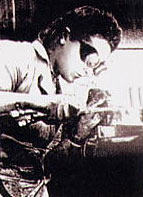|

 | |  | |
The following are memories recalled by Ena Gaddes, as recorded by Hanover Housing Association in their book 'Tale of the Century' published in 1999.
My first job was a typist for a very old, established sports goods company; but when war broke out the manufacture of luxury goods ceased and the factory output became very different.
Knowing that I enjoyed working with figures, I was asked if I would be interested in holding the post of Contracts Costing Clerk instead of being 'called up'. My weekly wage was increased from one pound to one pound five shillings.
We used adding machines in those days and hand wrote the figures into a ledger using pen and ink. I did this job for abut three years. My mother was pleased as my siblings were all in the Forces.
Mr Churchill, the Prime Minister, broadcast as usual one evening and told the nation that the only way to beat the Nazis was to increase our factory output. Within days of the broadcast, recruitment of females to the forces almost stopped as they were directed into factory work.
Soon I received a little envelope that held instructions for me to report to the Labour Exchange. There I was told to report to a factory in Chiswick, West London the following week.
 My working hours were to be 7.30am to 6.30pm day shift for two weeks, followed by two weeks night shift from 7pm to 7am. I was trained to work a static drilling machine which meant I would stand on a wooden duckboard to do the job. It made my legs and back really ache. My working hours were to be 7.30am to 6.30pm day shift for two weeks, followed by two weeks night shift from 7pm to 7am. I was trained to work a static drilling machine which meant I would stand on a wooden duckboard to do the job. It made my legs and back really ache.
Later I was given the opportunity to train as a welder. I trained for three weeks, after which I sat a very stiff examination set by the Ministry of Aircraft Production. There were three types of welding design: a gate weld, a candle weld and a flat weld. I found out later that the welding test pieces were all parts of the Halifax bombers. We were allowed to keep these as souvenirs and I still have them.
My pay was increased from one shilling to two shillings an hour. During the process of welding, a white cloud from the flux would float upwards getting into our throats and making us cough. We were not allowed to wear scarves across our face because if they caught light our hair would catch fire. In winter out fronts were hot from the flames and our backs cold from the factory.
The blitz was taking place day and night during my time there, so we often lost sleep. Times were hard.
After the war I returned to my old job as a typist and was later promoted to Company Buyer. I took another job with a German Company in 1958 and stayed with that company for 23 years until I retired.
| |  | |  |
To add a comment you must first login or join for free, up in the top left corner.
|
|


